
Celtis is a genus of about 60–70 species of deciduous trees, commonly known as hackberries or nettle trees, widespread in warm temperate regions of the Northern Hemisphere. The genus is part of the extended Cannabis family (Cannabaceae).

Scorzonera is a genus of flowering plants in the tribe Cichorieae within the family Asteraceae.

Daniel Hunt Janzen is an American evolutionary ecologist and conservationist. He divides his time between his professorship in biology at the University of Pennsylvania, where he is the DiMaura Professor of Conservation Biology, and his research and field work in Costa Rica.

Telegonus fulgerator, the two-barred flasher, is a species of spread-wing skipper butterfly in the family Hesperiidae which may constitute a possible cryptic species complex. It ranges all over the Americas, from the southern United States to northern Argentina.
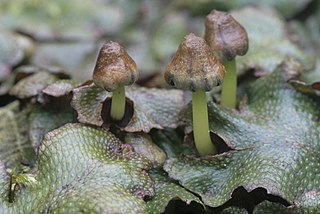
Conocephalum is a genus of complex thalloid liverworts in the order Marchantiales and is the only extant genus in the family Conocephalaceae. Some species of Conocephalum are assigned to the Conocephalum conicum complex, which includes several cryptic species. Conocephalum species are large liverworts with distinct patterns on the upper thallus, giving the appearance of snakeskin. The species Conocephalum conicum is named for its cone-shaped reproductive structures, called archegoniophores. Common names include snakeskin liverwort, great scented liverwort and cat-tongue liverwort.

Crepis, commonly known in some parts of the world as hawksbeard or hawk's-beard, is a genus of annual and perennial flowering plants of the family Asteraceae superficially resembling the dandelion, the most conspicuous difference being that Crepis usually has branching scapes with multiple heads. The genus name Crepis derives from the Greek krepis, meaning "slipper" or "sandal", possibly in reference to the shape of the fruit.

Arachidonate 5-lipoxygenase-activating protein also known as 5-lipoxygenase activating protein, or FLAP, is a protein that in humans is encoded by the ALOX5AP gene.
John Burns is an entomologist, curator of Lepidoptera and professor at Department of Entomology, Smithsonian Institution.
Phytoecdysteroids are plant-derived ecdysteroids. Phytoecdysteroids are a class of chemicals that plants synthesize for defense against phytophagous insects. These compounds are mimics of hormones used by arthropods in the molting process known as ecdysis. When insects eat the plants with these chemicals they may prematurely molt, lose weight, or suffer other metabolic damage and die.

Centrosema, the butterfly peas, is a genus of American vines in the legume family (Fabaceae). It includes 44 species, which range through the tropical and warm-temperate Americas from the southern United States to northern Argentina. Species include:
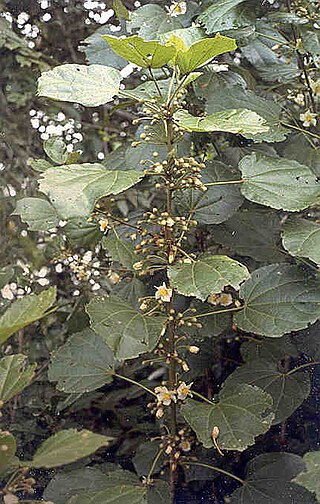
Hampea is a genus of flowering plants in the family Malvaceae. They are trees native to Mexico, Central America, and Colombia. There are about 21 species.

Capparis is a genus of flowering plants in the family Capparaceae. It includes 142 species of shrubs or lianas which are collectively known as caper shrubs or caperbushes. Capparis species occur over a wide range of habitat in the subtropical and tropical regions of Africa, Eurasia, Australasia, and the Pacific.
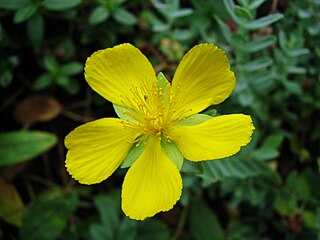
Hypericum olympicum, commonly known as the Mount Olympus St. John's wort, is a species of flowering plant in the family Hypericaceae found in the Balkans and Turkey and introduced to western Europe. It has been widely cultivated for centuries because of its large, showy flowers, which are far larger than those of most other species in Hypericum.

DNA barcoding is a method of species identification using a short section of DNA from a specific gene or genes. The premise of DNA barcoding is that by comparison with a reference library of such DNA sections, an individual sequence can be used to uniquely identify an organism to species, just as a supermarket scanner uses the familiar black stripes of the UPC barcode to identify an item in its stock against its reference database. These "barcodes" are sometimes used in an effort to identify unknown species or parts of an organism, simply to catalog as many taxa as possible, or to compare with traditional taxonomy in an effort to determine species boundaries.

Iris kashmiriana is a plant species in the genus Iris, it is also in the subgenus Iris. It is a rhizomatous perennial, from Kashmir, India. It has straight, sword-shaped, glaucous leaves, tall, thick stem with up 2 short branches, which hold 2–3 flowers, which can be white, cream or pale blue, lilac, lavender or blue-purple. It is cultivated as an ornamental plant in temperate regions, although in Kashmir, it is also planted on graves.

Professor Surendra Nath Pandeya (1939–2012) was an Indian medicinal and organic chemist. He made several contributions in the design and discovery of anticonvulsant, antitubercular, anti-HIV, anti-cancer, antibacterial, and antimicrobial molecules. His research focused on semicarbazones, Mannich bases, thiadiazoles, benzothiazoles, and oxindole compounds.

Winifred Hallwachs is an American tropical ecologist who helped to establish and expand northwestern Costa Rica's Área de Conservación Guanacaste (ACG). The work of Hallwachs and her husband Daniel Janzen at ACG is considered an exemplar of inclusive conservation.
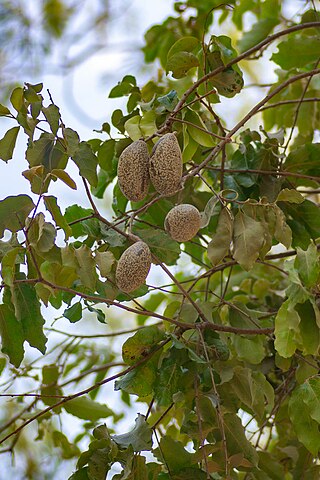
Licania pyrifolia, commonly known as merecure, is a species of flowering tree in the family Chrysobalanaceae. It has large green fruits, similar in size to the avocado, greenish with whitish freckles. It is widespread in the Llanos or Great Plains of the Orinoco river. The fruit is edible and it used to be planted near the Fundos for shade because it is evergreen and because of its fruit. It contains compounds that can be used to control snails and other mollusks harmful to crops. Its Latin name alludes to its leaves being similar to those of the pear tree. It is the flagship tree of the state of Apure in Venezuela.

Boscia angustifolia is a shrub or small tree with lanceolate leaves commonly found in the savannah zones of Africa, from Senegal moving eastwards to Sudan. It is part of the Capparaceae family. The plant is also known as the rough-leaved shepherds tree.
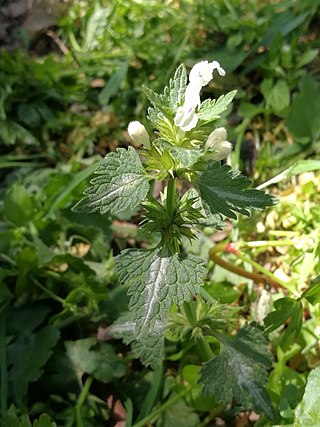
Lamium bifidum is a species of flowering plant in the mint family Lamiaceae, native to the Southern Europe. It was first described by botanist Domenico Cirillo in 1788.


















